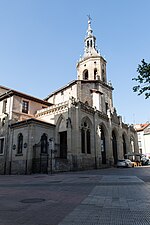Museo de Bellas Artes de Álava
1942 establishments in SpainArt museums and galleries established in 1942Art museums and galleries in SpainMuseums in Vitoria-Gasteiz

The Museum of Fine Arts of Álava (Spanish: Museo de Bellas Artes de Álava, Basque: Arabako Arte Ederren Museoa) is located in Vitoria-Gasteiz, the capital of the Basque Country, Spain. The museum is dedicated to Spanish art from the 18th to the 20th century, and particularly to Basque art from the 1850–1950 period. Opened in 1942, it is located at the Augustin Zulueta Palace.
Excerpt from the Wikipedia article Museo de Bellas Artes de Álava (License: CC BY-SA 3.0, Authors, Images).Museo de Bellas Artes de Álava
Frai Francisco Vitoria ibilbidea/Paseo Fray Francisco de Vitoria, Vitoria-Gasteiz Mendizorrotza
Geographical coordinates (GPS) Address External links Nearby Places Show on map
Geographical coordinates (GPS)
| Latitude | Longitude |
|---|---|
| N 42.8417 ° | E -2.6797 ° |
Address
Arte Ederren museoa/Museo de Bellas Artes
Frai Francisco Vitoria ibilbidea/Paseo Fray Francisco de Vitoria 8
01007 Vitoria-Gasteiz, Mendizorrotza
Autonomous Community of the Basque Country, Spain
Open on Google Maps











